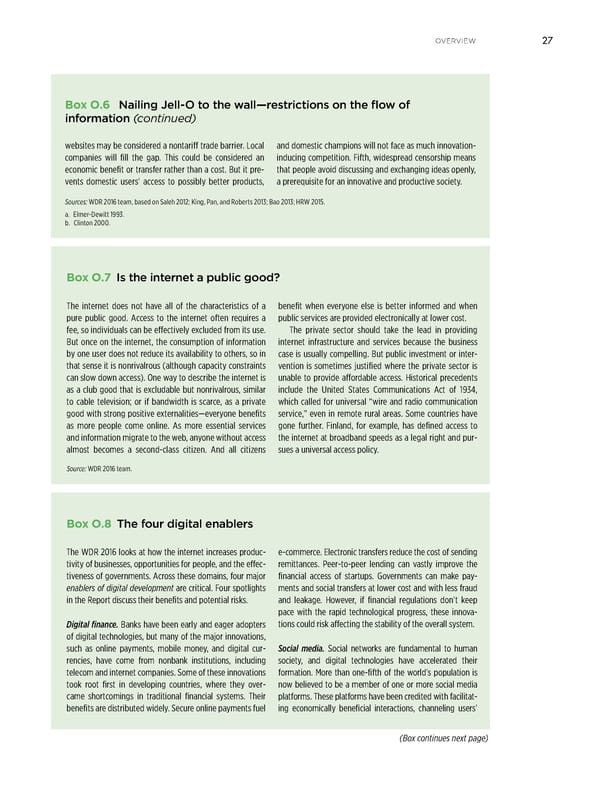overview 27 Box O.6 Nailing Jell-O to the wall—restrictions on the flow of information (continued) websites may be considered a nontariff trade barrier. Local and domestic champions will not face as much innovation- companies will fill the gap. This could be considered an inducing competition. Fifth, widespread censorship means economic benefit or transfer rather than a cost. But it pre- that people avoid discussing and exchanging ideas openly, vents domestic users’ access to possibly better products, a prerequisite for an innovative and productive society. Sources: WDR 2016 team, based on Saleh 2012; King, Pan, and Roberts 2013; Bao 2013; HRW 2015. a. Elmer-Dewitt 1993. b. Clinton 2000. Box O.7 Is the internet a public good? The internet does not have all of the characteristics of a benefit when everyone else is better informed and when pure public good. Access to the internet often requires a public services are provided electronically at lower cost. fee, so individuals can be effectively excluded from its use. The private sector should take the lead in providing But once on the internet, the consumption of information internet infrastructure and services because the business by one user does not reduce its availability to others, so in case is usually compelling. But public investment or inter- that sense it is nonrivalrous (although capacity constraints vention is sometimes justified where the private sector is can slow down access). One way to describe the internet is unable to provide affordable access. Historical precedents as a club good that is excludable but nonrivalrous, similar include the United States Communications Act of 1934, to cable television; or if bandwidth is scarce, as a private which called for universal “wire and radio communication good with strong positive externalities—everyone benefits service,” even in remote rural areas. Some countries have as more people come online. As more essential services gone further. Finland, for example, has defined access to and information migrate to the web, anyone without access the internet at broadband speeds as a legal right and pur- almost becomes a second-class citizen. And all citizens sues a universal access policy. Source: WDR 2016 team. Box O.8 The four digital enablers The WDR 2016 looks at how the internet increases produc- e-commerce. Electronic transfers reduce the cost of sending tivity of businesses, opportunities for people, and the effec- remittances. Peer-to-peer lending can vastly improve the tiveness of governments. Across these domains, four major financial access of startups. Governments can make pay- enablers of digital development are critical. Four spotlights ments and social transfers at lower cost and with less fraud in the Report discuss their benefits and potential risks. and leakage. However, if financial regulations don’t keep pace with the rapid technological progress, these innova- Digital finance. Banks have been early and eager adopters tions could risk affecting the stability of the overall system. of digital technologies, but many of the major innovations, such as online payments, mobile money, and digital cur- Social media. Social networks are fundamental to human rencies, have come from nonbank institutions, including society, and digital technologies have accelerated their telecom and internet companies. Some of these innovations formation. More than one-fifth of the world’s population is took root first in developing countries, where they over- now believed to be a member of one or more social media came shortcomings in traditional financial systems. Their platforms. These platforms have been credited with facilitat- benefits are distributed widely. Secure online payments fuel ing economically beneficial interactions, channeling users’ (Box continues next page)
 World Development Report 2016 Page 41 Page 43
World Development Report 2016 Page 41 Page 43